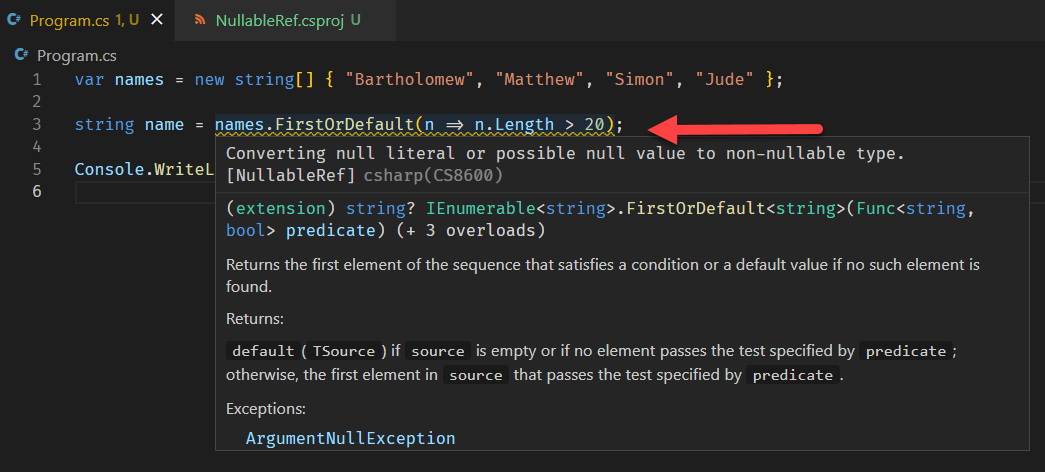30 Days Of .NET 6 - Day 23 - Nullable References
[.NET, C#, 30 Days Of .NET 6]
The great computer scientist Tony Hoare, credited with inventing the null reference, famously confessed this to be his ‘billion dollar mistake’.
Developers of all ages, ranks and experience are VERY familiar with the null reference, especially when it manifests as an exception.
A great deal of work (and code) goes into preventing these from arising in the first place, as well as detecting them when they arise and recovering from them.
.NET 6 has introduced a new approach to dealing with this problem - you can specify whether or not you want the compiler to aggressively check for conditions where a value potentially evaluates to null and catch this at compile time.
Take this code:
var names = new string[] { "Bartholomew", "Matthew", "Simon", "Jude" };
string name = names.FirstOrDefault(n => n.Length > 20);
Console.WriteLine(name);
If you try to build it, you will get this warning:
C:\Projects\BlogCode\NullableRef\Program.cs(3,15):
warning CS8600: Converting null literal or possible null value to non-nullable type.
[C:\Projects\BlogCode\NullableRef\NullableRef.csproj]
1 Warning(s)
You will also get a warning in the IDE

Note the exact expression does not matter - you would still get the warning whether or not the expression was satisfied.
What is happening here is as follows:
The query
names.FirstOrDefault(n => n.Length > 20)
can return exactly one of two options:
- A
string, if the expression found at least one match - A
null, if the expression was not satisfied
If a null is returned, this will be assigned to the name variable.
But we have specified that name is a string.
If we want to signal that we are OK with getting back a null, we change the code like this:
string? name = names.FirstOrDefault(n => n.Length > 20);
This signals to the compiler that we expect name to be either a string, or a null, and therefore the code will compile without any warnings.
In other words string? tells the compiler that “this is a string, but it might also be a null; and I am OK with that.”
This feature is called nullable references, and is controlled at project level.
If you open the .csproj you should see the following:
<Project Sdk="Microsoft.NET.Sdk">
<PropertyGroup>
<OutputType>Exe</OutputType>
<TargetFramework>net6.0</TargetFramework>
<ImplicitUsings>enable</ImplicitUsings>
<Nullable>enable</Nullable>
</PropertyGroup>
</Project>
The idea here is to force you to think about how to handle the edge case when your expression does not return anything.
You could handle this by using the new overload for FirstOrDefault where you specify a default. This we talked about in this post
string notNullName = names.FirstOrDefault(n => n.Length > 20, "");
If we do this, there is no way anything other than a string is returned. So the return is never null.
To turn OFF this feature entirely, which is ON by default, change Nullable to disable. With this the project will behave like it was prior to .NET 6.
Thoughts
This feature should help developers catch some very subtle bugs at compile time, resulting in better quality code.
The code is in my Github.
TLDR
Nullable references allow developers to catch possible bugs due to unexpected null values at compile time, and will enforce better domain design.
Happy hacking!
This is Day 23 of the 30 Days Of .NET 6 where every day I will attempt to explain one new / improved thing in the upcoming release of .NET 6.